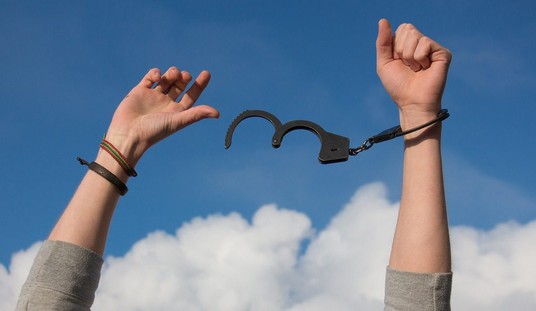The Contra commander had told me the night before that we had to make what would be a hike totaling eight hours, to inspect another camp along the Honduran border. The problem was that my equipment hadn’t yet arrived, and the knee-deep mud would surely suck off my sneakers. I could have gone barefoot, like the indigenous, but the commander insisted I grab a pair of jungle boots from supply.

Newly captured Soviet-made, hand-held, surface-to-air missiles being unloaded off a chopper at one of the Contra bases, while the prisoner who was handed over by the Nicaraguan village he terrorized, Sandinista Major Parrothead, looks on from the background—a scarlet macaw rests on his right shoulder.
Photo by Cork Graham
The only size they had was one size too small: just big enough to fit snugly. By the first hour, I knew I was in trouble. By hour three, I was not only being assaulted by a mind repeatedly saying, I told you so, but by sharp stabbing pains along the sides of my feet. By the time we had finished our visit, and were headed back to our base, I had shucked the boots, and carried them over my shoulder.
All that moisture. All that friction. All that pressure. The damage had been done. For the next five years, just putting on and wearing leather shoes was an ordeal.
Guns and knives, these are the things the warrior or hunter’s mind jumps to when getting ready. But, just as much attention needs be put to the pressure points: feet and shoulders; boots and packs. You can’t do anything if you can’t move, or carry weight.
After a statement on the comfort of the Blackhawk! Warrior Wear Desert Ops Boots by gunwriter Dave Douglas, I sought about evaluating a pair, along with the A-III MOLLE pack from Eagle Industries, while on a two-day trip for fresh boar meat at the Native Hunt Ranch in Monterey County—the owner was complaining of a pig on the property that had killed two dogs, chased a client, and broke off half a tusk by trashing the refrigerator and cooking area at the lodge. His days were numbered.
First impression of the Desert Ops Boots was that it’s not only a light pair of boots, but also extremely comfortable. Light is good, as long as the loss of weight doesn’t go hand-in-hand with loss of durability and sturdiness. For this reason, and solid grip on slippery logs and granite, I’ve normally only stayed with logger-type, all-leather boots with Air-bob soles, for hiking steep terrain in the US. Based on the very pliable CORDURA, abrasion-resistant suede, it’s easy to think that what would be lost is ankle support. Nothing could be further from the truth.
While the boots not only provide an almost luxurious comfort, the boot stood the demands of climbing gravel, rock and extremely steep canyon walls. To many, who do a lot of hiking, that extra bit of cushioning might be a warning sign. Too much cushion and give, and your feet and calves become even more stressed and fatigued, because the foot prefers to feel ground and searches for the resistance of that ground as the foot comes down. What the Warrior Wear Ops Boot does is provide just the right amount of cushioning, yet also enough resistance. These are also great looking boots, and can easily be worn like the more fashionable ankle-high hiking boots.

Blackhawk! Warrior Wear Desert Ops Boots, Eagle Industries A-III pack MOLLE and a pure-strain Turkish wild boar taken with an old 8mm Mauser cavalry carbine.
Photo by Cork Graham
As for the A-III pack MOLLE, it’s a three-day pack. Perfect for taking a day hike, or hunting from base camp. The main cargo area is 2,240 cubic inches. That’s enough to carry a boned-out blacktail deer or a medium-sized pig. It’s also enough to carry a small sleeping bag, survival sheet, knife, extra ammo, and some food. Water can be carried in a bladder, as the Blackhawk! Tempest II 100oz Hydration Pack did well on this trip, with the bladder’s hose easily accessible through a Velcro patch-covered hole at the top of the pack. And since the pack uses MOLLE, you can add pouches to the outside, as I’ve done with a SAW magazine pouch, to carry binoculars, and, or, rangefinders, saving the use of the main cargo area for larger loads.
Many choose a pack in the store without loading it with weight, and focusing only on the feel of the padded shoulder straps. What those who use those packs for a long time quickly learn is that like possible “over-cushioning” in boots, over-padded straps work against the user. Instead of just dealing with the weight, you subconsciously begin fighting the give and sway of the straps. For this very reason, after years of using every new-fangled rifle sling, I’ve gone back to a traditional all-leather military sling: it can be used in a variety of shooting positions, and the leather gives just enough to keep from cutting into a shoulder, but it’s still firm enough to keep down your minute reactions and compensations, which only serve to tire out the shoulder muscles and fatigue the body.
One of the cautions about using tactical equipment for non-military purposes is that most packs these days are built to be worn over armor, so there is an assumption there’s already a level of support. Though I was used to the ALICE packs, without a frame, and traditional hunting pack frames of the 1980s, the level of comfort that has been afforded through more sport-oriented packs, and even military-type, of late, is outstanding.
Instead of a flimsy piece of padding between the user and load, the A-III has about a quarter-inch of thickness: enough give to keep something in the cargo area from jabbing into your side or back, while being compression-resistant enough to deal with load pressure and sway, once you tighten down the four, appropriate and well-placed, quick-release-buckled snug straps.
Overall, I’d give the boots and pack a resounding A-plus, with a focus on the A-III as a ranch pack, vehicle bug-out bag, or pack for a day or weekend trip into the mountains. Using good, properly fitted boots and packs will keep you from having to deal with nerve, bone, and a host of other problems years later.
To setup a hunting trip to John Steinbeck Country, contact Native Hunt at http://www.nativehunt.com
For more information on the boots, pack and hydration system, visit the following sites:








Join the conversation as a VIP Member